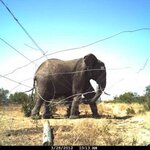Researchers report that they have discovered a new genus and species of electric knifefish in several tributaries of the Negro River in the Amazonia State of Brazil.
Professor Cristina Cox Fernandes at UMass Amherst, with Adília Nogueira and José Antônio Alves-Gomes of INPA, describe the new bluntnose knifefish in the current issue of the journal Proceedings of the Natural Sciences of Philadelphia and detail the new genus and species' anatomy, range, relationship to other fish, salient features of its skeleton, coloration, electric organs and patterns of electric organ discharge (EOD).
True…
Ecology & Zoology

Researchers have discovered little-known cave insects, four distinct but related species in the genus Neotrogla, with rather novel sex lives - the first example of an animal with sex-reversed genitalia.
Not sex roles, like the alphabet of letters we get in western culture, actual sex organ reversal.
That's not the only fascinating aspect.Copulation lasts an impressive 40 to 70 hours and the female insects insert an elaborate, penis-like organ into males' much-reduced, vagina-like opening.
The researchers speculate that the insects' sex organs and sex-role reversal may have been driven over…

Carbon dioxide, in its ionic form bicarbonate, has a regulating function in the splitting of water in photosynthesis. This means that carbon dioxide has an additional role to being reduced to sugar, according to scientists at Umeå University in Sweden.
Inorganic carbon in the form of carbon dioxide, CO2, is reduced in photosynthesis to organic compounds in the chloroplasts. Less well known is that inorganic carbon also affects the rate of the photosynthetic electron transport and thus the rate of photosynthetic oxygen production. This result was first published by the Nobel Prize winner…

Researchers recently used an array of high-speed video cameras operating at 7,500 frames a second to capture the wing and body motion of Drosophila hydei
after they encountered an image of an approaching predator.
The fruit flies are about the size of a sesame seed and rely on a fast visual system to detect approaching predators. And scientists found out that even Top Gun pilots might be envious of the screaming-fast banked turns and slick moves the flies employed. In the midst of a banked turn, the flies can roll on their sides 90 degrees or more, almost flying upside down at…

It is barely possible to see the parasitic worm Amakusaplana acroporae when it sits on its favorite hosts, the staghorn coral Acropora, thanks to its excellent camouflage. However, new research from the University of Southampton has found that the small flatworm could cause significant damage to coral reefs.
The flatworm has been scientifically described very recently and has been found in the wild only in one location on the Great Barrier Reef so it's surprising it the Reef has made it this long. The flatworm is well known to aquarium hobbyists, who keep staghorn corals and fear…

Ruminant cows and sheep account for a major proportion of the methane produced around the world - an estimated 20 percent of global methane emissions stem from ruminants.
In the atmosphere, methane is a shorter-term problem than CO2 but has 23X the warming effect – that's why researchers are looking for ways of reducing methane production. Comparatively little is known about the methane production of other animal species, but one thing seems to be clear: Ruminants produce more of the gas per amount of converted feed than other herbivores.
The only other animal group that regularly "…

Guess who’s not being displayed in the Monterey Bay Aquarium's new "Tentacles" exhibit, opening April 12? Who is just too difficult for this award-winning institution to handle?
Flashy tropical octopuses are all showing up for work. The world's smallest cephalopod is on the billing. Even specimens of the deep sea are likely to make an appearance.
So who's the diva too delicate to display? Local squids.
That's right. Two species that live in the Aquarium's backyard, market squid and Humboldt squid, are apparently anti-exhibitionists.
California's market squid (Doryteuthis opalescens…
A new initiative is underway to breathe life back into the 700,000-gallon ocean tank at Biosphere 2. The new ocean at Biosphere 2 will provide a glimpse into the sea that's closest to Southern Arizona – the Gulf of California, which stretches for a thousand miles from the mouth of the Colorado River to Mazatlan on the mainland of Mexico.
The original "ocean" was one of several habitats intended to sustain a crew of scientists living and working inside the Biosphere 2 dome isolated from the outside world. When the "enclosed missions" ended in 1994, the fragile ecology of the ocean habitat…

Enjoy Greek yogurt?
Maybe, if you hate nature.
Because it is now a $2 billion a year industry, activists have turned on it, a fate that the $29 billion organic food industry has so far escaped.
One Green Planet says the greek yogurt manufacturing process is "creating an ecological nightmare beyond all comprehension" which tells you that no one at One Green Planet can do simple math. And they are prone to hyperbole. It is entirely in my ability to comprehend what a cup of yogurt can do.
It takes three ounces of milk to make an ounce of yogurt and any excess whey acid is useless - well,…

Wildlife fences are constructed for lots of reasons, including having them killed by cars (and people along with them) to prevent the spread of disease and to protect small small populations of threatened species.
Near more populated areas, the concern is different; predatory animals will wantonly kill livestock and ruin crops, a few threaten human lives.
Separating people and wildlife by fencing is a mutually beneficial way to avoid detrimental effects but a paper in Science, clearly written by people who clearly do not live near bears, wolves or mountain lions, argues it is a last…
